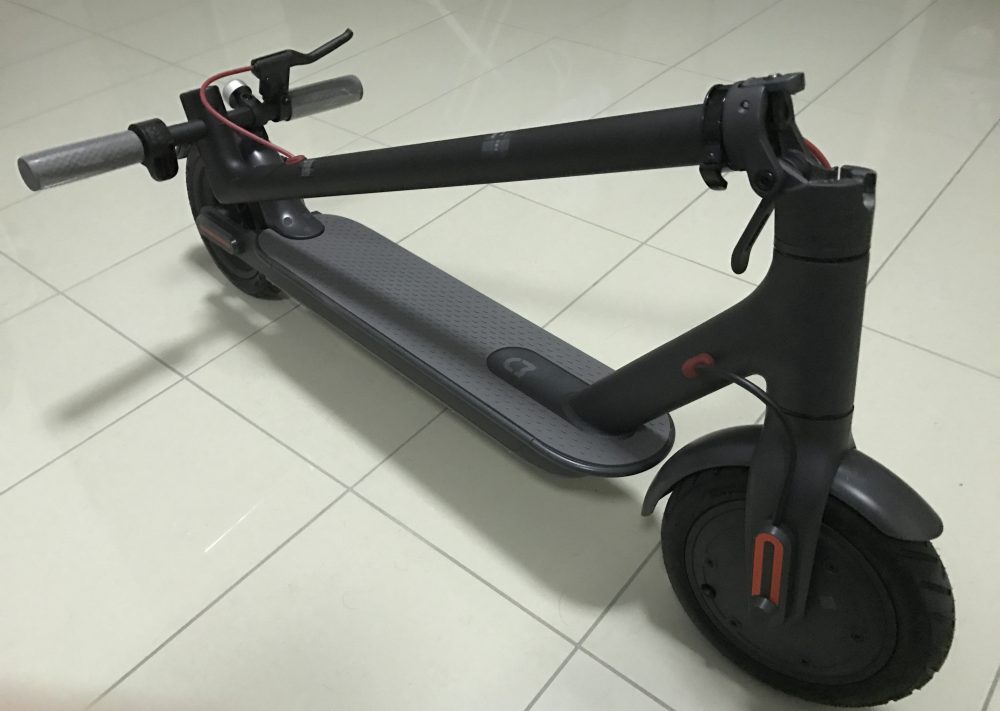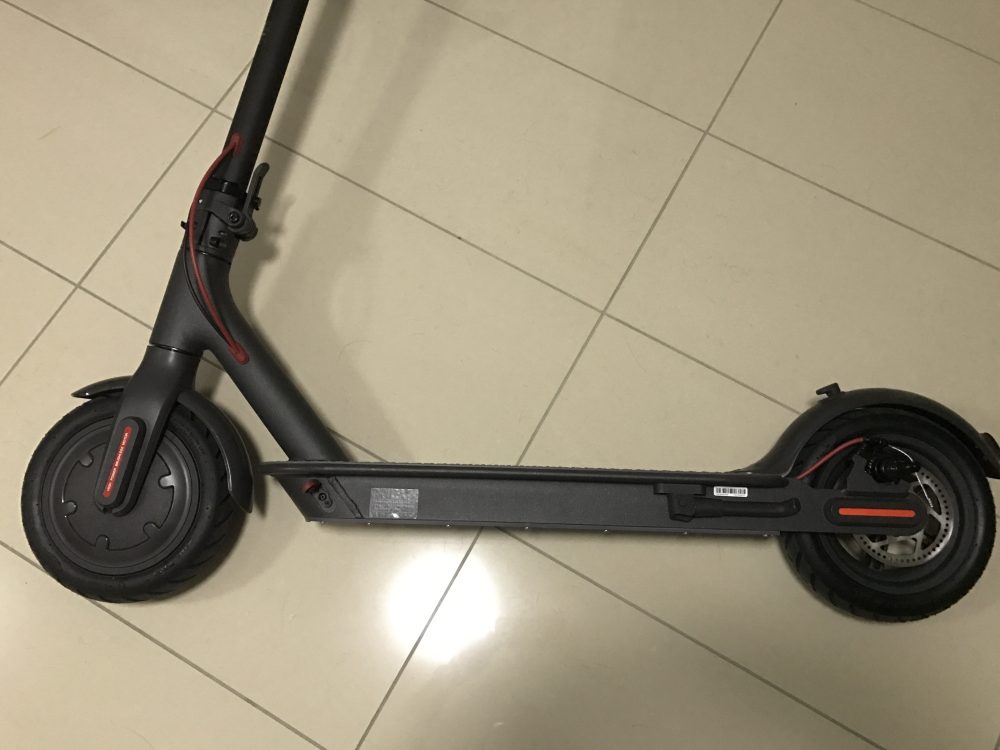The Xiaomi M365 Electric Scooter
I couldn’t find the Xiaomi app in the Australian App Store when I went to look, but I found the Ninebot app on the first go. It’s pretty basic, but does let you rename your electric scooter and adjust the level of regenerative breaking. But hang on a second, this all seems very weird. How does a Chinese manufactured and marketed scooter, with not a word of English in the user manual, works with an app that has near-perfect English? Something doesn’t add up here.
After doing a little internet sleuthing, I discovered Ninebots were originally manufactured by a Chinese company as a kind of personal mobility device. They’re kind of like Segways, except a little more discreet and don’t have the traditional Segway handlebar design. Still, none of that explains how the M365 is able to connect to the Ninebot app. Did Xiaomi reverse-engineer the app to such a degree that every feature works perfectly with their own electric scooter hardware, down to the regenerative braking setting and the cruise control mode?
As it turns out, Ninebot is a Xiaomi-backed company. It’s perhaps one of the simplest explanations for why the M365 works with the Ninebot app; being the parent company and all, you’d hardly want to go to the trouble of developing an entirely new app when one of your subsidiaries already has something that does exactly what you’re after. It’s not perfect (the Ninebot app doesn’t recognise my M365 as an valid Ninebot), but there’s nothing that I’m missing out on that I can see. My KMs even count towards the weekly and overall distance travelled leaderboards.
What does all of this have to do with Segway? Well, Segway complained to a US trade commission that several Chinese companies were infringing on its patents. They complained in September 2014, and not a year later, they were acquired by the Xiaomi-backed Ninebot in August 2015, which is all pretty hilarious when you think about it.
I’m still not sure how delivery works to my apartment building. There’s basically a 50/50 chance that I’ll just get carded, or whether there’ll be a package sitting outside my front door. Most of the time, it’s safer to just get things delivered to work, and as a result, I’ve had a lot of personal packages delivered to work. Some are larger than others: a new set of luggage. A 1/6th scale figurine. The Xiaomi M365, however, was definitely the largest and heaviest thing I’ve ever had delivered to work.
The Xiaomi Mijia M365 is an electric scooter. It has a 25KM/h top speed, 30KM range, and cost me about $700 landed. It has some delightful design features, looks pretty cool, and is a blast to ride around.
The first time I jumped on the M365, I pressed the accelerator hoping that it would just take off. When nothing happened, panic set in as I wondered if my scooter was faulty. Would I have to send it back? What would that even be like, shipping it all the way back to China? Willing to try anything to make my $700 electric scooter work, I tried giving it a kick start. I pushed off, engaged the motor, and was immediately wowed by the near-silent but steady acceleration in my workplace’s loading dock.
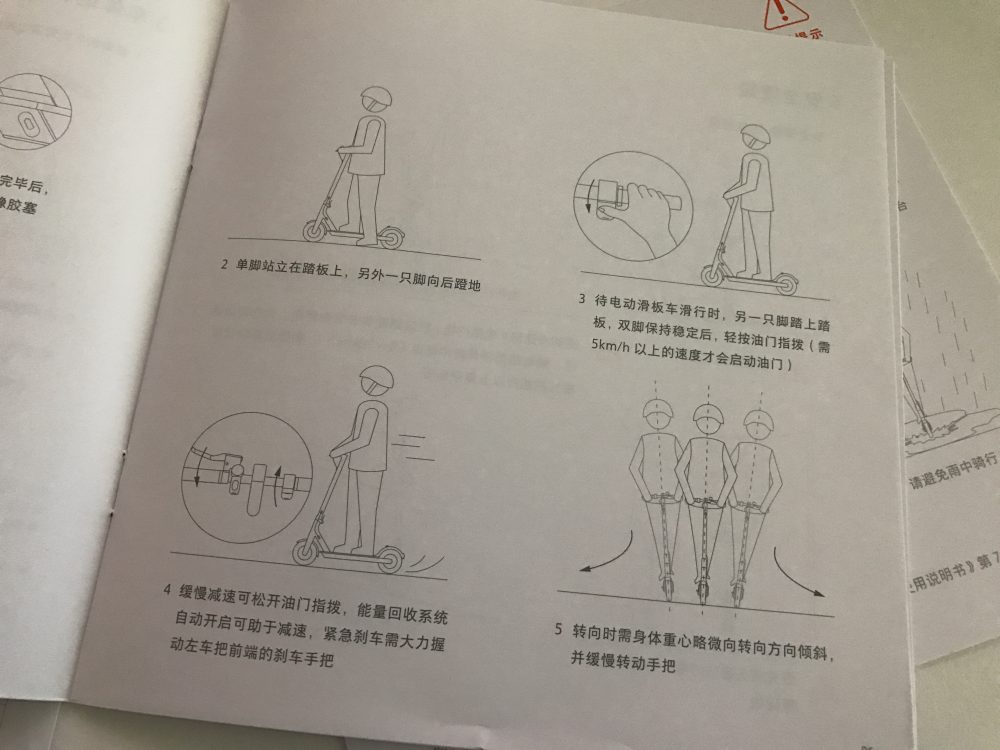
There are pictures, but the rest of the manual is in Chinese. Thankfully, technology has progressed to the point where you can take a picture of Chinese and have broken English come out on the other side.
It wasn’t until later, when I was individually translating the pages of the all-Chinese user manual, that I discovered that you need to be going at least 5KM/h before the motor will kick in. As pointed out by one of my friends on Twitter, it makes some sort of sense; there’s probably less chance of you falling off if you already have some kind of forward momentum, and there’s less strain on the motor than if it were to start from a standing start. This need to be going a certain speed before the motor kicks in also prevents the scooter from shooting off underneath you, not that that’s a particularly big concern given the modest power of the motor. Now that I think about it, the feature makes a lot of sense.
Unfortunately, this need to be going at some speed before the motor will engage also means that you can’t do sick burnouts. Not that the single front-wheel drive would have let you do sick burnouts anyway.
Making the M365 go is easy enough. There’s a little rotating mechanism on the right handlebar that you push down on with your right thumb. It rotates about 90°, which corresponds to how much juice you give the motor. Once you let go, the regenerative braking feature kicks in (more on this later), otherwise you’re carried by your own forward momentum.
There’s a standard brake handle on the left hand side, connected to the vented disc brake on the rear wheel. You can adjust how strong the brake is by tightening or loosening the cable. I’ve also noticed some kind of ABS-like feature where if you apply the brakes hard at speed, you’ll get a back wheel that doesn’t just skid out, but one that applies the brake in bursts, similar to how it would on a car. Whatever it is, there’s definitely some kind of brake-assist happening when you have the scooter turned on compared to when you’re just coasting along with the scooter turned off. How much you’ll use the brakes will largely depend on how often you need to come to a complete stop, versus how well you can judge how fast the regenerative braking feature slows you down.
Also located on the handlebar section is a decently bright LED light for illuminating your path ahead. Because of the way the stem is angled backwards, the LED is angled within its housing to throw about 3-4 metres ahead of you, aimed at where you’re going instead of blinding pedestrians or motorists.
No electric scooter would be complete without a bell for telling people to get out of your way, so it’s good to see Xiaomi included one of those, too. A cool design detail about this is that the “ringer” part you flip to strike the bell acts as a anchor point for a little rubber notch on the rear mudguard when folded, letting you lift the stem and bring the base with you. It’s a surprisingly elegant design for something that would have otherwise required some other way of attaching the handlebars to be rear mudguard to allow the entire thing to be folded up for storage or transport.
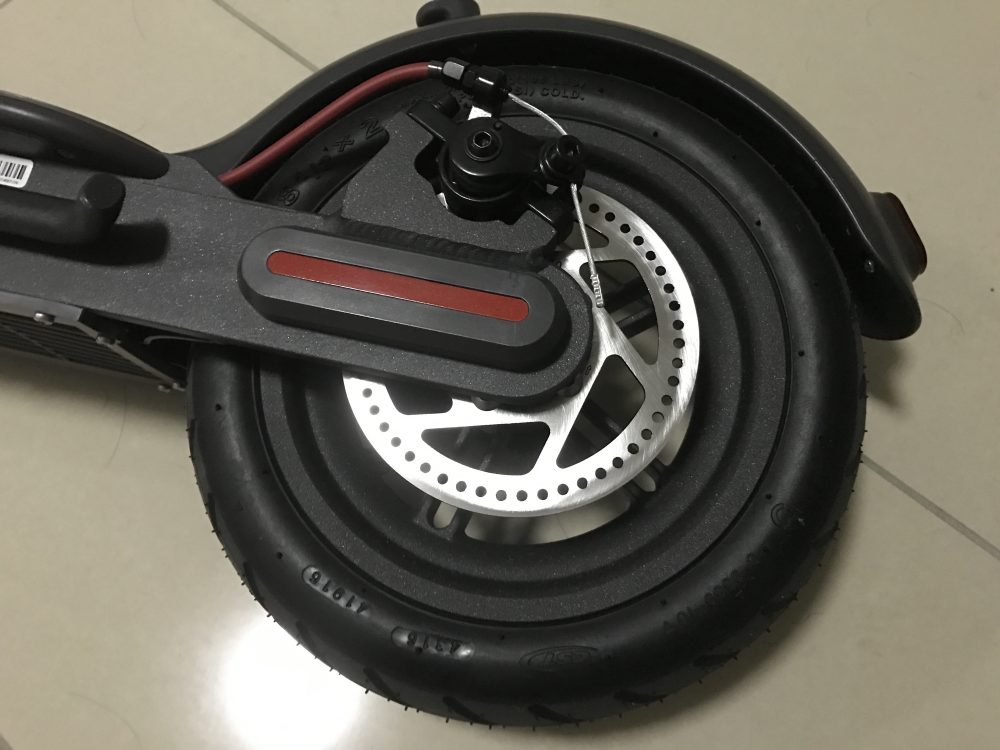
Mechanical disc brakes on the rear wheel. No kind of braking on the front, unless you’re counting the regenerative braking feature.
The product page for the M365 advertises a regenerative braking feature. I didn’t fully understand this at the time, but essentially it uses any forward momentum to recharge the battery. Using the Ninebot app, you can control how much energy is diverted to this regenerative braking feature. Setting this to low means you’ll experience much less “slowdown” when you’re no longer holding down the accelerator, while a “high” setting means that once you let go of the accelerator, you lose forward momentum much more quickly. I’ve mostly been riding on medium, but if your ride was mostly flat and continuous, it would be a better idea to use a low setting so you could travel further while coasting. Conversely, if your ride required frequent stops and/or had particularly tricky terrain, then a high setting might be the better option, so you could slow down faster after letting go of the accelerator.
The Ninebot app also describes a “cruise control” feature that says it’ll maintain the current speed of the scooter when you’ve held down the accelerator for five seconds. It works pretty much as you’d expect — there’s a short beep to let you know that you can stop holding down the accelerator with your thumb, and when you let go, the scooter continues at the current speed until you press the accelerator again or the brake.
One of the only major downsides of the M365 is that it has a somewhat underpowered motor. Legalities of riding this motorised scooter on footpaths aside, the 250W motor means that it’s really only suitable for riding on flat pavement. The official specs say it can handle inclines of up to 14%, but what does that mean? Basically, it can deal with minor inclines, or short steeper hills, but anything where you feel like you have to work harder to walk up the hill, and you’ll probably have to give it a manual push every now and again to help it along. You know, just like a real scooter.
That said, the 25KM/h advertised top speed is accurate provided you’re riding on quality pavement, and plenty fast enough to make you feel like you’re moving along at a decent clip. Going downhill you can probably get close to 30KM/h, but at those speeds things get pretty dodgy. Having two in-line wheels means that things are inherently less stable than the four you might get on a electric skateboard. The good news is, anything above about 16KM/h makes you feel like you’re moving.
I feel as though the advertised 30KM range is a little optimistic. Not by much, but my own usage in the months that I’ve owned the M365 says I get about 25KM before “range anxiety” sets in and I figure it needs a charge before taking it out again. If I pushed it a little more, I’d probably get close to the advertised range.
I was initially a little surprised about the battery capacity. The specs say there’s 7800mAH of juice in the tank, which doesn’t seem like a lot for the size and weight of the deck. I mean, you can get 10,000mAH power packs for your phone that fit in the palm of your hand, so I was kind of perplexed why the battery wasn’t a larger capacity. As it turns out, 7800mAh at 36V equates to 280Wh. By comparison, my late-2013 15-inch MacBook Pro with Retina display has a 98Wh battery, and that 20,000mAh power pack, at 5V, is 100Wh, so maybe the M365 has a decently large battery after all.
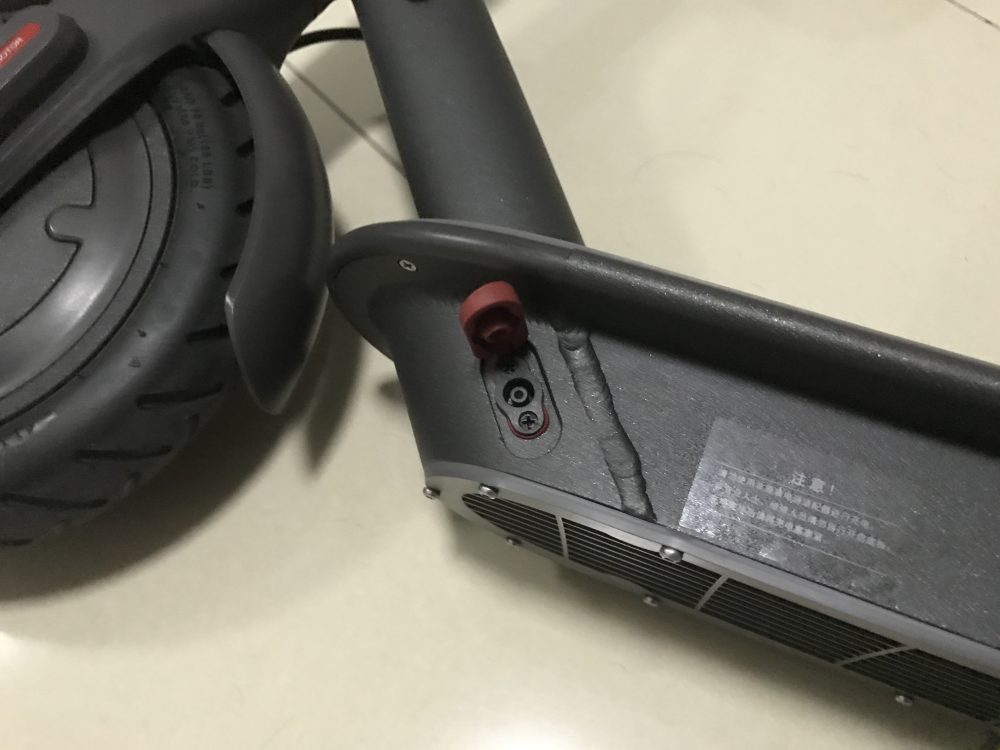
I describe the charging port as proprietary, but in reality it’s probably fairly standard, similar to a laptop charger.
Which brings us to charging. The M365 comes with a 71W (42V at 1.7A) external power supply, which connects to what looks like a proprietary port located on the deck, near the left hand side of the front wheel. While the M365 came with a US-style two-prong plug, the connector on the adaptor is a standard figure-8, meaning you can plug in any standard Australian cable with a figure-8 on the other end instead of using an adapter. Curiously, you have to have the scooter turned on before it will charge, lighting up the top indicators and gently pulsing the rear brake light to tell you that it’s charging. It takes about four to five hours to get a full charge, depending on how empty the battery is, and once it has reached full charge the scooter will automatically turn itself off after about an hour to prevent overcharging. The battery pack advertises its has umpteen different safety mechanisms to protect its LG-manufactured 18650 cells from any kind of dangerous conditions, but I doubt I’ll ever charge it overnight. Horror stories of hover boards spontaneously bursting into flames and burning down houses have more than taken care of that.
(No, seriously. A house right around the corner from mine burnt to the ground because a hover board burst into flames. It’s enough to put the fear of battery packs in your heart forever.)
Seeing as there’s no suspension or any kind of shock absorption on the M365, you feel every bump and crack in the pavement through the handlebars. Going over uneven pavement faster doesn’t help either, as all you get is a more severe jolt for your trouble. I’m not sure whether this is normal. It could have something to do with tyre pressure, but the wheels don’t look flat when I’m riding. I haven’t inflated the wheels since getting it, but if you need to, there’s a little inflation port, and the M365 comes with an adapter so you can use a standard bike pump.
The tyres are my main source of anxiety when it comes to the long-term ownership of the M365. What happens when I get a puncture? Where do I get replacement tyres from? Even if I can buy replacement tyres online, will I be able to disassemble the scooter to a point where I can replace the tyre, and then put it back together again? It’s not as if there’s some electric scooter repair centre I can just take my imported scooter into and expect them to have the exact replacement parts I’m after. Hopefully the tyres and any other part that’s likely to wear out with use are generic enough that I’ll be able to get replacements easily enough, but I can’t say I’m looking forward to it. I guess that’s the price you pay when choosing to import something from overseas; at least if you buy local you know you’ll have the support and backing of the company who designed and manufactured the thing.
But I digress.
Even with its oversized wheels, there’s still only 8-10cm of clearance between where the wheels make contact with whatever surface you’re riding on and the bottom of the deck (the part where you stand on). This makes mounting curbs an anxiety-filled task, and so far, I’ve managed to avoid the issue by using driveways and ramps wherever possible, but if I had to mount a standard Australian curb, you would definitely have to jump off and lift the scooter up and over the curb. So far I haven’t managed to scrape the bottom of the deck, but I’ve also been playing it very safe.
Which brings me to my next point: the M365 is kinda heavy. With an advertised weight of 12.5KG, it’s not really something you want to be hauling around if you can avoid it. When I was bringing it home from work the day it was delivered, I carried it home on the train. I had to put it down on the train because of how heavy it was, and I ended up rolling it the rest of the way home; I didn’t have a helmet at the time and wanted to play it safe. When the scooter is folded up, you can drag it along behind you on one wheel, although it’s a little unwieldy and takes some getting used to. Or you can carry it using one or both hands, and if you were looking for some inexpensive home gym equipment, the M365 would do in a pinch if you’re looking to do some bicep curls or something.
Another thing I’m reminded of when riding is that the M365 has a reasonably large turning circle. For whatever reason, the front wheel only rotates about 45° either side of centre, for a total of 90°, locking to a fixed centre position. When you’re riding it’s no big deal because you’re usually going fast enough for it not to matter, and turning that much all at once is dangerous, but when you’re just pushing the scooter along or trying to manoeuvre in and out of lifts it’s a little frustrating. What usually happens is I end up lifting the entire scooter up and swinging the deck and rear wheel around. In terms of manoeuvrability, you can kind of turn by leaning one direction or the other, but otherwise a small nudge in either direction is usually enough.
This large turning circle is also a stark contrast to the Segway experience, which can pirouette on the spot like some kind of exotic ballet dancer due to the way its wheels are horizontally-aligned. I feel as though the scooter does better at curbs than a Segway would, but I can’t remember how many curbs we did when we were riding around San Francisco.
But it’s not really fair to compare the M365 to a Segway, nor is it fair to compare it to an electric skateboard. Being an electric scooter, it’s neither of those things. It’s not self-balancing, you need to have both hands on the handlebars when riding, and you probably look a good deal nerdier riding it than you would a trendy electric skateboard. None of these aspects make it any less fun to ride. Blasting around streets on the way to work is all good and well, but I feel further exploration is needed before taking it on longer trips. I’m pretty sure I’ll have to avoid riding on roads. Thankfully, people haven’t seemed to mind me riding on footpaths.
I don’t think I would stop even if they wanted me to; the M365 is just way too fun to ride. Blasting past pedestrians on the way to work is fun in ways I wasn’t expecting, and my work commute a little more interesting is always a plus.
Continued over at Xiaomi M365 Electric Scooter Part II: Electric Boogaloo.
